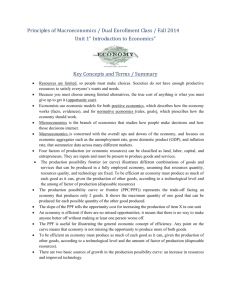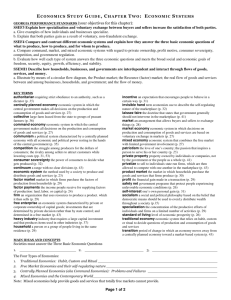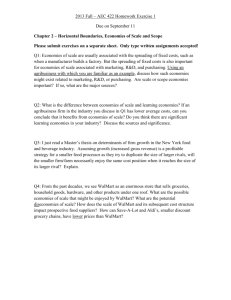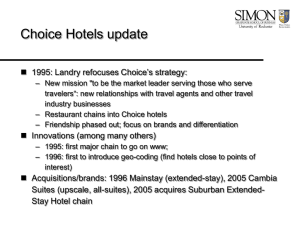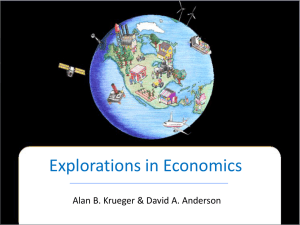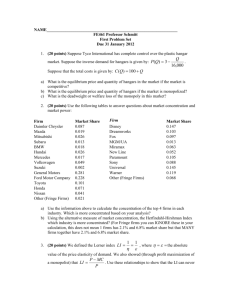Ch2Sec4
advertisement
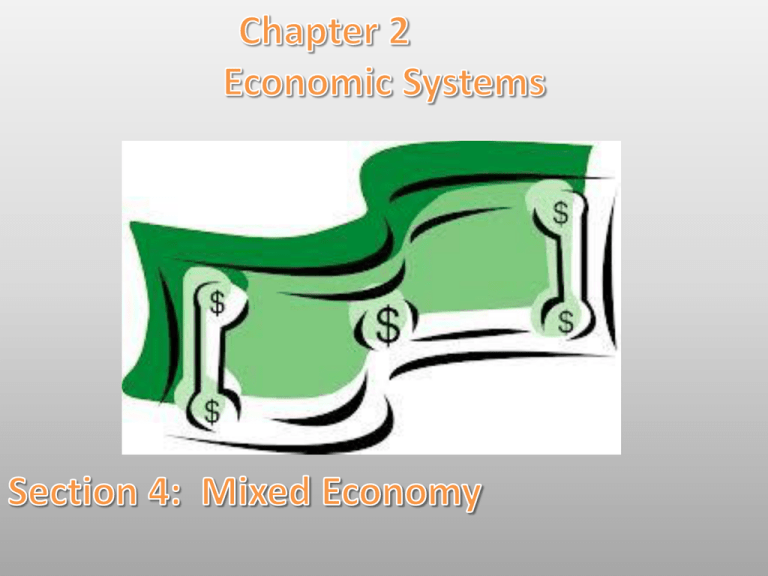
Lesson Objectives: By the end of this lesson you will be able to: *Explain the rise of mixed economic systems. *Interpret a circular flow model of a mixed economy. *Compare the mixed economies of various nations along a continuum between centrally planned and free market systems. *Describe the role of free enterprise in the United States economy. Economies and You Even though we experience a high level of economic freedom in the United States, we do have limits on our rights. For example, a person under 18 years of age cannot legally purchase certain items, and everyone who earns income in the United States must pay taxes. The Rise of Mixed Economies Every economic system has problems. *Traditional economies have little potential for growth or change. *Centrally planned economies do not allow innovation, do not meet consumer needs, and limit freedom. *Free market economies usually have an unequal distribution of wealth. Reasons for Government Involvement Early free market thinkers such as Adam Smith believed that the free market would provide the greatest benefit for consumers and raise the standard of living. They favored laissez faire (little to no government interference) in their markets. Yet even Smith acknowledged the need for a limited degree of government involvement. Over the years government intervention has increased for several reasons: 1. Needs of modern society would be difficult to meet in the marketplace (national defense). 2. Gov’t supplies some needs in order to ensure that all members of society can benefit (free public school education for all citizens). 3. Gov’t protects property rights (5th amendment protects life, liberty, & property). 4. Gov’t makes sure market exchanges are fair (product labels must be honest). No nation today has a pure free market economy or a pure command economy. Instead, most modern economies are mixed. A mixed economy is a market-based economic system in which the government is involved to some extent. The degree of government involvement varies from nation to nation. Balancing Needs and Freedom Every society must figure out their economic goals based on what is best for their nation. *Some goals are better met by open markets *Some goals may be better achieved through government action. Questions of a Mixed Economy: *Is the nation willing to pay taxes to fund the army? *Is the nation willing to give money to people who lose their jobs? *Is the nation willing to give all people an education? Circular Flow Model of a Mixed Economy Video Circular Flow Model of a Mixed Economy: Government in The Factor Market Firms purchase land, labor, & capital from households in the factor market. The same is true of governments. *For example, The U.S. government pays 2.7 million employees $152.2 billion dollars a year for their labor. Government in the Product Market Like households, governments purchase goods and services from firms in the product market. *For example, printing money requires many tons of paper and gallons of ink. These items are purchased from private firms. Transferring Money Government collect taxes from both households and businesses. Governments then transfer some of this money to businesses & individuals for a variety of reasons. The largest expenditure of the United States government is Social Security. Comparing Mixed Economies Mixed Economies Where Government Intervention Dominates North Korea represents this type of mixed economy. Like the former Soviet Union, communist North Korea has an economy almost totally dominated by the government. North Korea *The government owns all property & economic output. *State owned industries produce 95% of North Korea’s goods. *Imports from other countries are banned. China used to have this type of economy as well but they are currently going through economic transition. Economic transition is a period of change in which a nation moves from one economic system to another. In China’s case, the transition involves privatizing state-owned firms. Privatization is the process of selling businesses or services operated by the government to individual investors. Comparing Mixed Economies Continued Mixed Economies Where the Free Market System Dominates In Hong Kong, the private sector rules. The government protects private property and rarely interferes in the free market. The areas is highly receptive to foreign investment and places virtually no barriers on foreign trade. Banks in Hong Kong operate independently from the government, and foreign-owned banks have nearly all the rights of domestic ones. The United States Economy While the American economy is a mixed system, the foundation of the United States economy is the free market. An economic system characterized by individual or corporate ownership of capital goods is called a free enterprise system. In this system, investments in firms are made in a free market by private decision. Government Intervention The government of the United States plays a substantial role in the American economy. The American government: *Keeps order *provides vital services *promotes the general welfare *Federal & State laws protect private property. Some Americans argue that there is a need for more government services and stricter regulation of businesses while others say that the government already intervenes too much in the economy. Economic Freedom Overall, the United States enjoys a high level of economic freedom. Foreign investment and free trade are encouraged. The banking industry operates under relatively few restrictions. Foreign-owned banks have few additional restrictions.

